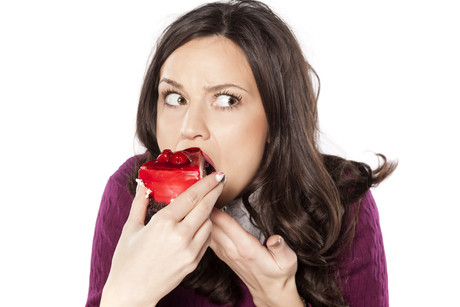Want your cake and eat it too? You might want to check the portion size

If you’ve been struggling to keep the weight off, you won’t be surprised to hear that portion sizes for Australia’s most commonly consumed junk foods have increased significantly. Between 1995 and 2012, pizza and cake kilojoules rose a sizeable 66%.
Researchers at the George Institute for Global Health have found that Australians are eating even bigger portions of food full of fat, sugar and salt.
Comparing data from 1995 to 2012, they found portion sizes for many of Australia’s most commonly consumed junk foods have risen significantly.
In addition to pizza and cake portions growing, typical portions of sausages, cereal bars, processed meats, ice-cream and wine have increased in size, too.
Dr Miaobing Zheng, of The George Institute for Global Health, said the results were worrying given that discretionary foods contribute about a third of Australia’s daily energy intake. “Over the past two decades we found that foods which provide very little nutritional benefit have surged in size, and this is helping to fuel Australia’s obesity epidemic.
“We had expected portion sizes to have grown but we were still surprised by just how much. It’s pretty disturbing that an average slice of cake has increased in size so much it now contains almost 1000 kilojoules more than it did two decades ago.”
The study published in the journal Nutrients also found the portion sizes of pastries, snack foods (potato crisps, popcorn, corn chips) and potato fries had actually decreased.
Research Fellow Zheng added: “We aren’t 100% sure why the portion sizes of these foods reduced, but if you take fries, for example, most fast food chains offer small portions, so it could be the case that people recognise these foods are unhealthy and consciously try and eat less of them. But unfortunately these foods items were the exception, not the norm.
“We know that people often under-report the amount of food and drink they consume, especially if they consider them ‘bad’ foods. So the true picture of what Australians are eating could be much worse.”
The team examined data from two different Australia-wide surveys — the 1995 National Nutrition Survey and the 2011–2012 National Nutrition Physical Activity Survey. Participants were asked to record everything they had eaten in a 24-hour period and were given photos and measuring guides to help them asses the size of their portions accurately.
Data was also recorded by age and sex. Researchers found serves of ice-cream eaten by women had increased in size by nearly a third.
Originally published here.
Remote laundries target preventable disease in NT communities
A new community laundry has launched in Borroloola, part of a program seeking to curb preventable...
Eye care partnership looks to support First Nations optometrists
A new scholarship initiative will support Aboriginal and/or Torres Strait Islander optometrists...
A Day in the Life of a mobile optometrist
Linda Nguyen is the owner and founder of mobile optometrist practice Care Optometry and was a...

![[New Zealand] Transform from Security Awareness to a Security Culture: A Vital Shift for SMB Healthcare — Webinar](https://d1v1e13ebw3o15.cloudfront.net/data/89856/wfmedia_thumb/..jpg)
![[Australia] Transform from Security Awareness to a Security Culture: A Vital Shift for SMB Healthcare — Webinar](https://d1v1e13ebw3o15.cloudfront.net/data/89855/wfmedia_thumb/..jpg)




